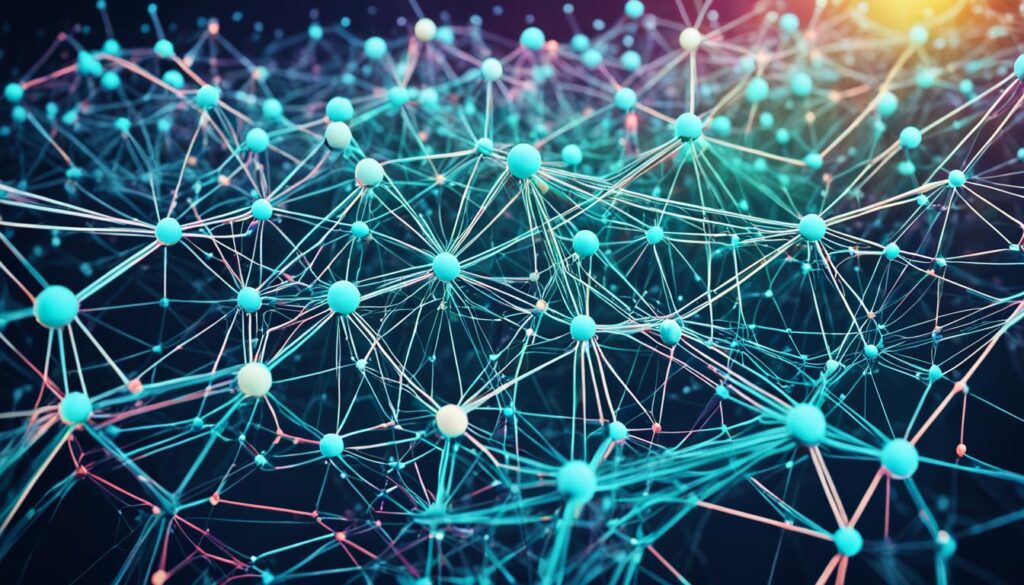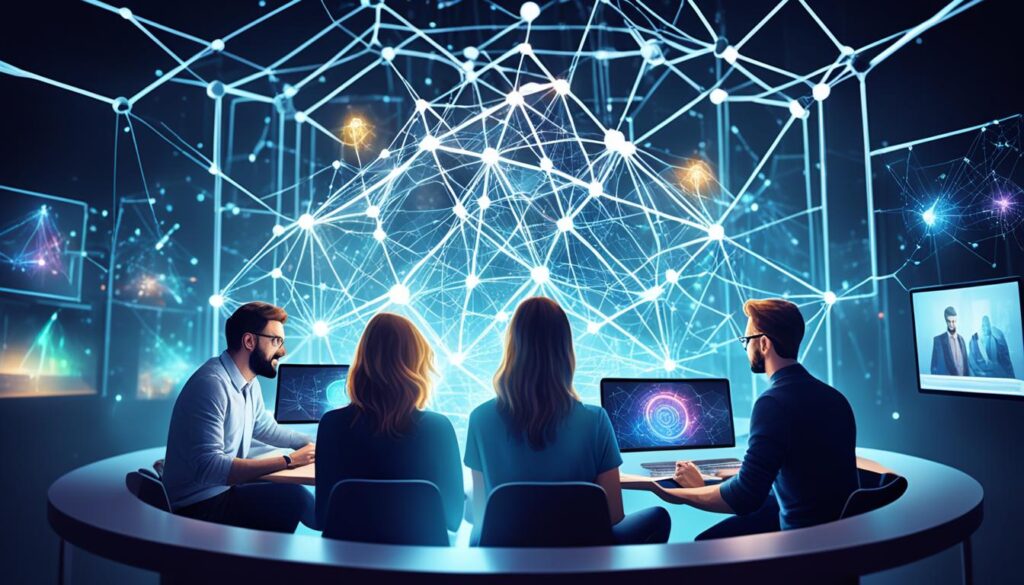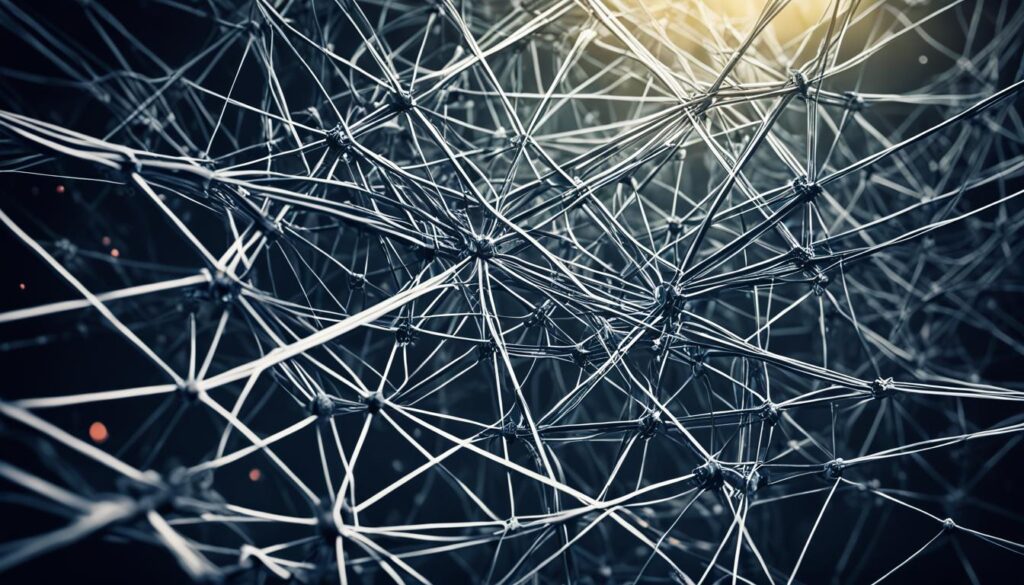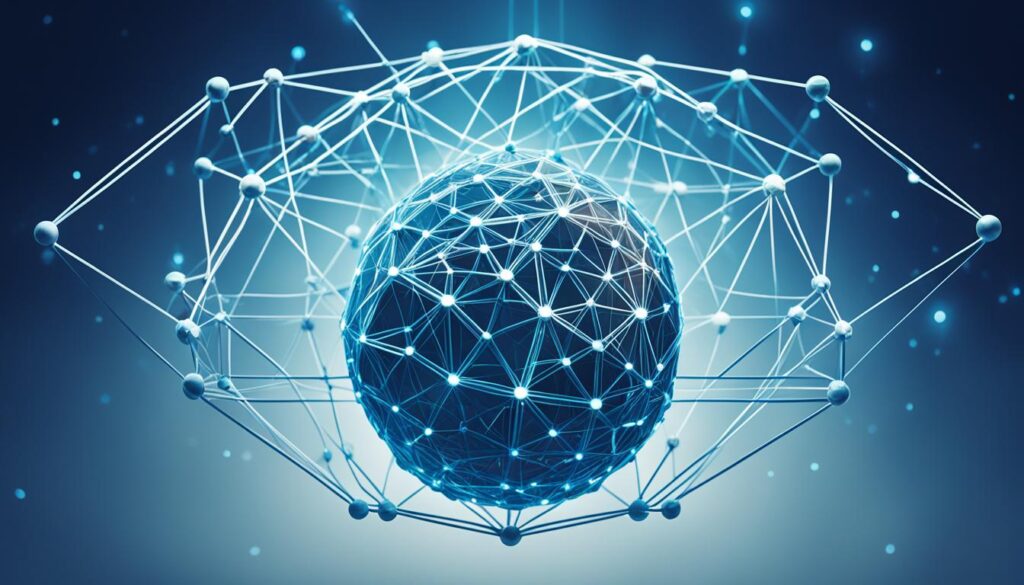Welcome to the world of Web 3.0, the next phase of the internet’s evolution! As technology advances, so does our digital landscape, and Web 3.0 is at the forefront of this transformation. Gone are the days of static web pages and limited interactions. Web 3.0 brings us a more intelligent, decentralized, and user-centric digital ecosystem.
This exciting new era is driven by emerging technologies like artificial intelligence, machine learning, blockchain, and the Internet of Things (IoT). These technologies enable machines to understand, process, and exchange information without human intervention. With Web 3.0, the internet becomes a place where data is not only consumed but interpreted, making interactions more dynamic and personalized.
The features of Web 3.0 go beyond providing a seamless browsing experience. It revolutionizes the way we connect, transact, and explore online. By leveraging blockchain technology, Web 3.0 ensures greater security and transparency. It also empowers users by giving them ownership of their data and control over their online presence.
The future of the internet lies within this transformative digital landscape. As Web 3.0 continues to evolve, it will reshape industries, enhance privacy and security, and unlock new possibilities for individuals and businesses. Join us on this journey to discover the immense potential that Web 3.0 holds for the future of the internet.
Key Takeaways:
- Web 3.0 is the next phase of the internet’s evolution, characterized by intelligent data interpretation and decentralized architecture.
- Emerging technologies like AI, machine learning, blockchain, and IoT are driving the development of Web 3.0.
- Web 3.0 offers a more immersive, secure, and user-centric digital ecosystem.
- The global Web 3.0 market is projected to reach $81.5 billion by 2030.
- Web 3.0 revolutionizes various industries and enhances privacy and security.
The Rise of Web 3: From Fiction to Reality
Web 3.0 is not just a fantasy of science fiction. It is becoming a reality, thanks to the rapid advancement of emerging technologies such as Artificial Intelligence (AI), machine learning, blockchain, and the Internet of Things (IoT). These cutting-edge technologies are paving the way for a new era of the internet, one that is more immersive, decentralized, and secure.
Web 3.0 is not just a buzzword; it is a thriving industry with exponential growth. The global Web3 market is projected to continue expanding at an impressive average annual rate of 44.6% until 2030. This remarkable growth is a testament to the immense potential of Web 3.0 in revolutionizing the digital landscape.
Let’s delve into the integration of these emerging technologies within Web 3.0:
- Artificial Intelligence (AI): AI is at the heart of Web 3.0, enabling intelligent data interpretation, automation, and personalized experiences. With AI-driven algorithms, websites and applications can deliver tailored content and recommendations, enhancing user engagement and satisfaction.
- Machine Learning: Machine learning algorithms empower Web 3.0 platforms to improve over time, leveraging user data and behavior patterns. This enables the creation of more intelligent, adaptive, and personalized experiences that cater to individual preferences.
- Blockchain: The decentralized nature of blockchain technology is a crucial component of Web 3.0. Blockchain enables secure, transparent, and tamper-resistant transactions and data storage, eliminating the need for intermediaries. This not only enhances security but also promotes trust and collaboration in the digital realm.
- Internet of Things (IoT): The integration of IoT with Web 3.0 introduces a new level of interconnectedness and automation. Smart devices can seamlessly communicate and exchange data, leading to more efficient and intuitive user experiences. From smart homes to industrial automation, the IoT is revolutionizing various sectors.
The integration of these technologies within Web 3.0 is transforming the way we interact with the digital world. It empowers individuals, provides immersive experiences, and ensures greater control over personal data and privacy. By leveraging AI, machine learning, blockchain, and IoT, Web 3.0 holds the potential to create a digital ecosystem that is more intelligent and user-centric.

Decentralization: The Power to the Masses
One of the most exciting aspects of Web 3.0 is its decentralized nature, where power shifts from centralized entities to the hands of the masses. Traditional Web 2.0 platforms are often centralized, with data controlled by a few powerful entities.
In contrast, Web 3.0 leverages blockchain technology, which facilitates peer-to-peer interactions and data ownership, empowering users to have greater control over their information. Blockchain acts as a digital ledger, recording and verifying transactions in a transparent and secure manner.
This decentralized approach eliminates the need for intermediaries, allowing individuals to directly interact and transact with each other. It promotes a more democratic online environment, where users have the freedom to engage in peer-to-peer interactions without relying on centralized authorities.
“Web 3.0 is not controlled by one entity or organization, it’s an ecosystem built by the people, for the people.”
Through decentralization, Web 3.0 enhances transparency, as all transactions and data are stored in a decentralized network of computers. This transparency fosters trust and accountability, as information is accessible and verifiable to all participants.
Moreover, decentralization improves security by removing single points of failure. With data fragmented across a distributed network, it becomes more resilient to cyber attacks and unauthorized access. Blockchain’s cryptographic algorithms further ensure the integrity and immutability of data.
Another benefit of decentralization is data ownership. In Web 2.0, users often surrender their personal data to centralized platforms, leaving them with little control over how it is used. In Web 3.0, individuals retain ownership of their data and can choose to share it selectively or even monetize it directly.
This shift in power from centralized entities to the masses promises a future where individuals have greater autonomy, privacy, and control over their online activities. It marks a significant step towards a more democratic and user-centric digital landscape.

The Benefits of Web 3.0 Decentralization
Decentralization in Web 3.0 brings several benefits:
- Enhanced transparency and accountability
- Improved security and resilience
- Greater data ownership and control
- Elimination of intermediaries
- Fostering trust in peer-to-peer interactions
- Promoting democratic participation
The transformative power of decentralization in Web 3.0 is empowering individuals, ensuring a more equitable and user-driven internet experience.
Challenges of Web 3.0
While Web 3.0 offers exciting possibilities, it also faces significant challenges. The complex nature of Web 3.0 technologies requires users and developers to invest time and effort in learning and understanding them. The adoption of Web 3.0 may also be hindered by scalability issues often associated with blockchain-based systems. Additionally, regulatory concerns must be addressed to strike a balance between innovation and public interests. The lack of user-friendly interfaces poses a challenge, especially for non-technical users who may struggle to navigate and utilize Web 3.0 platforms effectively. Furthermore, the integration of artificial intelligence (AI) in Web 3.0 raises ethical questions related to data privacy and AI bias.
“Web 3.0 technologies introduce complexity and present a learning curve for both users and developers. The scalability of blockchain-based systems is an ongoing challenge that needs to be addressed for wider adoption. Regulators play a crucial role in shaping the future of Web 3.0, ensuring compliance and protecting user interests. User-friendliness is key to driving adoption and realizing the full potential of Web 3.0. Ethical considerations surrounding AI integration and data privacy are crucial for building trust and ensuring responsible use of technology.”
Addressing these challenges will be essential for the successful evolution and wide-scale adoption of Web 3.0. By finding solutions to complex technical issues, improving user interfaces, and establishing appropriate regulations, the full potential of Web 3.0 can be realized in a manner that is secure, user-friendly, and ethical.
Web 3.0 Challenges
| Challenge | Description |
|---|---|
| Complexity | Web 3.0 technologies can be complex and require learning for users and developers. |
| Scalability | Blockchain-based systems face scalability issues that can hinder wider adoption. |
| Regulatory Concerns | Finding the right balance between innovation and public interests requires addressing regulatory concerns. |
| User-Friendliness | Lack of user-friendly interfaces limits adoption, particularly for non-technical users. |
| AI Integration and Data Privacy | The integration of AI in Web 3.0 raises ethical questions related to data privacy and AI bias. |

Despite these challenges, the potential benefits of Web 3.0 make it a worthwhile endeavor. Overcoming these obstacles will drive the evolution of the internet towards a more intelligent, decentralized, and user-centric future.
Potential Applications of Web 3.0
Web 3.0 brings forth a plethora of applications that have the potential to revolutionize various industries. Let’s explore some of the exciting possibilities:
Decentralized Finance (DeFi)
Web 3.0 is facilitating the development of decentralized finance applications, also known as DeFi. These applications leverage blockchain technology to provide individuals with access to financial services without the need for traditional banking systems. With DeFi, users can engage in lending, borrowing, and trading activities directly on the blockchain, bypassing the intermediaries typically involved in traditional finance.
Revolutionized Social Networking
Web 3.0 is empowering users by giving them control over their data and privacy on social media platforms. Unlike traditional social networks, Web 3.0 platforms utilize decentralized technologies to ensure that user data is owned and managed by the individual. This shift towards user-centric social networking provides a more secure and personalized online experience.
Integration with the Internet of Things (IoT)
Web 3.0 seamlessly integrates with the Internet of Things (IoT), creating a secure and interconnected network of smart devices. By leveraging blockchain and decentralized technologies, Web 3.0 enables devices to communicate and interact with each other autonomously. This integration opens up countless opportunities for creating intelligent, automated, and efficient IoT ecosystems.
Enhanced Supply Chain Management
The transparency and traceability offered by blockchain technology in Web 3.0 have the potential to greatly improve supply chain management. By utilizing smart contracts and decentralized ledgers, Web 3.0 enhances accountability and streamlines the tracking of goods throughout the supply chain. This enables businesses and consumers to verify the authenticity and origin of products, ensuring trust and reducing fraud.
Gaming and Virtual Reality Experiences
Web 3.0 revolutionizes the gaming industry by introducing true ownership of in-game assets and enabling peer-to-peer transactions. With blockchain technology, players have ownership and control over their virtual assets, allowing for secure and transparent trading. Additionally, virtual reality experiences are enhanced through Web 3.0, creating immersive and interactive gaming environments.
Web 3.0 applications extend far beyond these examples, presenting opportunities for innovation, efficiency, and user empowerment across numerous sectors. As technology continues to evolve, it is essential for businesses and individuals to stay informed and explore the transformative potential of Web 3.0.
Enhanced Privacy and Security in Web 3.0
Web 3.0 is committed to safeguarding user privacy and protecting sensitive data. Through the implementation of encryption and decentralized storage, Web 3.0 offers enhanced security measures and grants users greater control over their personal information. With encryption, data is transformed into unreadable code, making it difficult for unauthorized individuals to access or decipher. Additionally, decentralized storage ensures that data is distributed across multiple nodes and not stored in a central location, reducing the risk of data breaches.
By prioritizing privacy and data protection, Web 3.0 empowers individuals to determine how and when their information is shared. This user-centric approach enables users to have ownership and control over their data, fostering a more secure online environment. With Web 3.0, users can trust that their personal information is not being exploited or accessed without their consent.
Web 3.0 revolutionizes the way we handle and secure data. With encryption and decentralized storage, users are no longer at the mercy of centralized platforms. Instead, they have the power to protect their own privacy and control their personal information.
Benefits of Enhanced Privacy and Security in Web 3.0
1. Ownership and Control: Web 3.0 allows individuals to have ownership and control over their own data, reducing reliance on central authorities.
2. Data Protection: Encryption and decentralized storage methods secure personal information, lowering the risk of data breaches and unauthorized access.
3. User Empowerment: Web 3.0 empowers users to make informed decisions about their privacy and provides tools to protect their data.
4. Transparency: The decentralized nature of Web 3.0 ensures greater transparency in data handling, reducing the likelihood of hidden tracking or surveillance.
| Enhanced Privacy and Security in Web 3.0 | Benefits |
|---|---|
| Encryption | Secures personal information |
| Decentralized storage | Reduces the risk of data breaches |
| Ownership and Control | Empowers individuals |
| Data Protection | Lowers the risk of unauthorized access |
| Transparency | Reduces hidden tracking or surveillance |
With the implementation of encryption and decentralized storage, Web 3.0 sets a new standard for privacy and security on the internet. Users can enjoy peace of mind knowing that their personal information is protected and controlled by them. As Web 3.0 continues to evolve, privacy and security will remain central pillars, ensuring a safer and more user-oriented digital ecosystem.

The Transformative Potential of Web 3.0
Web 3.0 represents a paradigm shift in the way we perceive and utilize the internet. By embracing decentralization, privacy, and user empowerment, it has the potential to transform various industries and reshape the digital landscape. Web 3.0 brings intelligence, decentralization, and personalized experiences to the internet. As Web 3.0 continues to evolve, individuals and businesses need to adapt and explore the opportunities it presents.
Conclusion
Web 3.0 ushers in a new era for the internet, offering intelligent, decentralized, and personalized experiences. It is reshaping the way we connect, interact, and transact online, paving the way for a more user-centric digital landscape. As Web 3.0 continues to evolve, individuals and businesses must embrace this transformative technology and fully comprehend its potential impact on the future of the internet.
The journey towards Web 3.0 is characterized by curiosity, caution, and enthusiasm. It presents an exciting time to explore the possibilities and opportunities that lie ahead. With intelligent data interpretation, advanced technologies like artificial intelligence and blockchain, and the empowerment of individuals through decentralized systems, Web 3.0 offers a promising future for the internet.
For individuals, Web 3.0 means more control over personal data, enhanced privacy and security, and the ability to curate personalized online experiences. Businesses can leverage Web 3.0 to innovate, streamline operations, and engage with customers on a deeper level. As we move forward, understanding the intricacies of Web 3.0 will be crucial for staying relevant in the digital age.
In short, the future of the internet lies in Web 3.0. By embracing its principles of intelligence, decentralization, and personalization, we can shape a more inclusive, secure, and interconnected online world. Let us embark on this journey with optimism, knowing that the potential of Web 3.0 is vast and the possibilities are limitless.
FAQ
What is Web 3.0?
Web 3.0, also known as the decentralized web, represents the next phase of the internet’s evolution. It is characterized by intelligent data interpretation, enabling machines to understand, process, and exchange information without human intervention. Web 3.0 seeks to create a more open, secure, and user-centric digital ecosystem.
What technologies are driving the development of Web 3.0?
Emerging technologies like artificial intelligence, machine learning, blockchain, and the Internet of Things (IoT) are driving the development of Web 3.0, making it more immersive, decentralized, and secure.
How fast is the Web 3.0 market projected to grow?
The global Web 3.0 market is projected to continue growing at an average annual rate of 44.6% until 2030, with a total market size expected to reach $81.5 billion in the same year.
What is the main advantage of Web 3.0’s decentralized nature?
One of the most exciting aspects of Web 3.0 is its decentralized nature, where power shifts from centralized entities to the hands of the masses. This empowers users to have greater control over their information and enhances transparency, security, and censorship resistance.
What are some challenges of Web 3.0?
Web 3.0 technologies can be complex and require learning for users and developers. Adoption may be slow due to scalability issues of blockchain-based systems. Regulatory concerns, such as finding the right balance between innovation and public interests, need to be addressed. Lack of user-friendly interfaces limits adoption, particularly for non-technical users. Moreover, the integration of AI in Web 3.0 raises ethical questions related to data privacy and AI bias.
What are some potential applications of Web 3.0?
Web 3.0 opens up numerous potential applications across various industries. Decentralized finance (DeFi) applications are being developed, providing access to financial services without relying on traditional banking systems. Web 3.0 revolutionizes social media platforms by giving users control over their data and privacy. Integration with the Internet of Things (IoT) enables a secure and interconnected network of smart devices. Supply chain management can benefit from Web 3.0’s transparency and traceability through blockchain technology. Gaming and virtual reality experiences are enhanced with true ownership of in-game assets and peer-to-peer transactions.
How does Web 3.0 prioritize user privacy and data protection?
Web 3.0 prioritizes user privacy and data protection. With encryption and decentralized storage, users have more control over their personal information and can decide how and when it is shared. Web 3.0 aims to create a more secure online environment where individuals have ownership and control over their data, reducing the risk of data breaches and unauthorized access.
What is the transformative potential of Web 3.0?
Web 3.0 represents a paradigm shift in the way we perceive and utilize the internet. By embracing decentralization, privacy, and user empowerment, it has the potential to transform various industries and reshape the digital landscape. Web 3.0 brings intelligence, decentralization, and personalized experiences to the internet.








